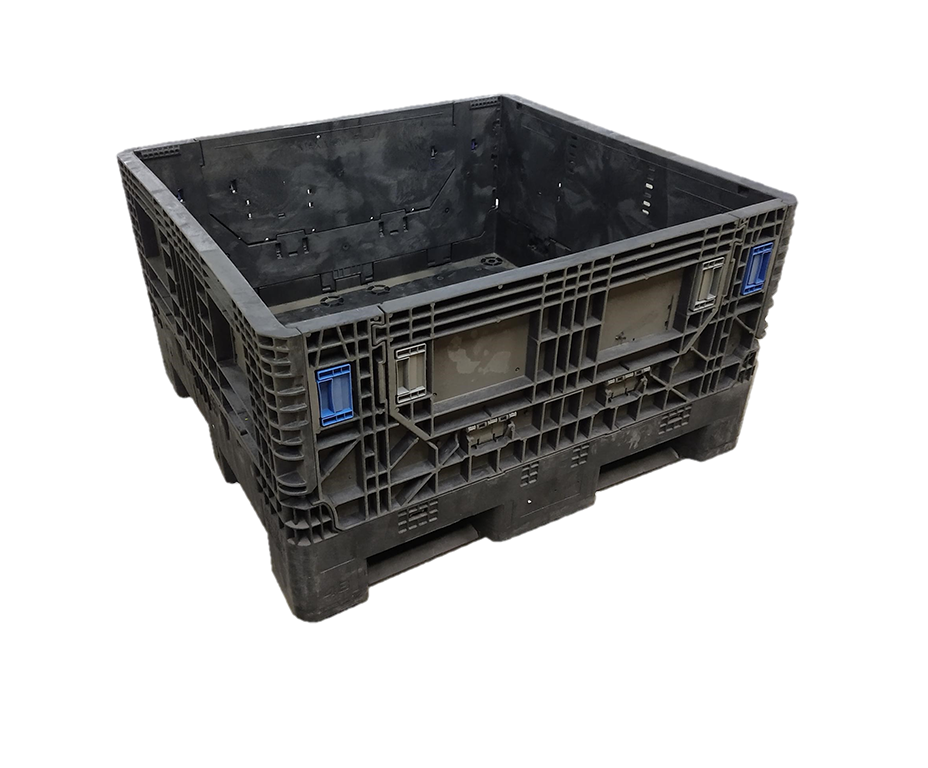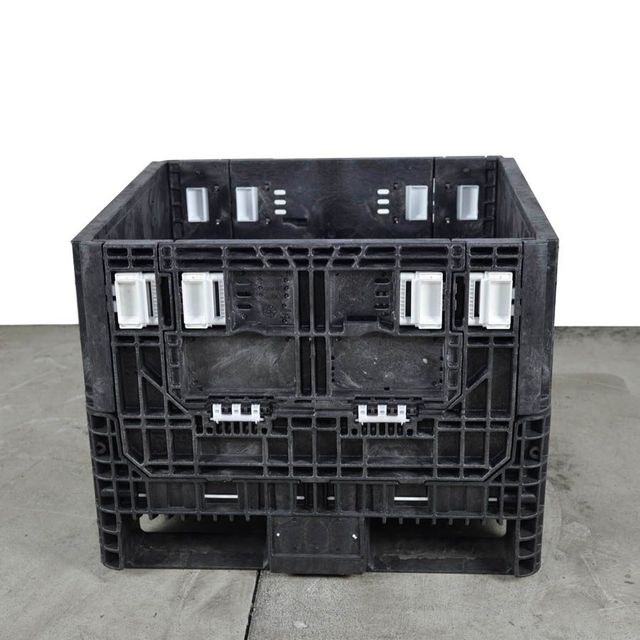The Ultimate Guide to Picking the Right Mass Containers for Your Company Requirements
Picking the appropriate bulk containers is essential for any type of company that relies upon effective logistics. Various kinds of containers exist, each made for particular products and applications. Variables such as size, product compatibility, and regulatory requirements play a considerable duty in this decision-making process. Recognizing these aspects can cause improved functional effectiveness. However, lots of services overlook important aspects that might improve their total performance and sustainability. What are these considerations?
Comprehending Different Sorts Of Mass Containers
Mass containers act as necessary devices for companies seeking effective storage and transport options. These containers are available in different types, each designed to meet details operational needs. One usual type is the intermediate mass container (IBC), which is ideal for granulated and fluid materials, supplying a balance of ability and maneuverability. Another popular option is the mass bag, or FIBC, suitable for dry, flowable products. These flexible containers are light-weight and can be easily delivered and stored. For larger products, rigid bulk containers are often utilized, supplying longevity and stability for secure handling. In addition, there are specific containers tailored for dangerous products, making certain conformity with safety and security laws. Understanding the unique characteristics of these bulk container types enables businesses to make informed decisions that enhance logistics and reduce costs. By selecting the ideal container, companies can boost their functional performance and improve their supply chain processes.
Key Material Factors To Consider for Bulk Containers
When choosing bulk containers, it is vital to consider the materials utilized in their building. Aspects such as toughness, chemical, and stamina compatibility play a crucial duty in making certain the containers satisfy details functional demands. Furthermore, weight and portability issues can influence both effectiveness and transport logistics.
Material Longevity and Strength
Resilience and strength are crucial elements in selecting products for mass containers, as they directly affect the container's capability to withstand numerous ecological problems and taking care of processes. Products such as high-density polyethylene (HDPE), polypropylene, and stainless steel are generally preferred for their durable buildings, offering resistance to effect, temperature level, and abrasion changes. The option of material likewise influences the general lifespan of the container; stronger products usually result in much less constant substitutes, leading to cost financial savings with time. In addition, the weight of the material can influence shipping expenses and simplicity of handling. Organizations should consider their details operational atmospheres and the possibility for wear and tear to assure peak durability and strength in their mass container choice.
Chemical Compatibility Elements
Understanding chemical compatibility is vital for choosing bulk containers, as the products made use of need to stand up to the details substances they will hold. Various aspects affect compatibility, consisting of the chemical nature of the materials, temperature level, and duration of storage. Destructive chemicals may require containers made from stainless steel or specialized plastics that withstand degradation. Furthermore, reactive compounds can generate warm or gases, necessitating vented or pressure-rated containers. The selection of container material, whether steel, polycarbonate, or polyethylene, need to align with the chemical buildings of the saved compounds to stop leaks or breaches. Ultimately, a comprehensive evaluation of these compatibility elements guarantees risk-free handling and storage space, safeguarding both personnel and the atmosphere while keeping product integrity.
Weight and Transportability Issues
Picking mass containers involves not just assessing chemical compatibility however likewise taking into consideration weight and portability. Companies have to examine the convenience of handling and transport to enhance performance. Light-weight materials like high-density polyethylene (HDPE) or light weight aluminum can help with less complicated movement and reduce delivery costs. On the other hand, much heavier containers might offer improved resilience but can impede movement, particularly in atmospheres needing regular relocation. In addition, the layout of the container need to enable for practical training and stacking, making sure ergonomic safety for employees. Business need to additionally consider the framework available for transportation; as an example, containers compatible with forklifts or pallet jacks can enhance operations. Eventually, the appropriate balance in between weight and portability directly affects functional efficiency and price effectiveness.
Sizing Your Bulk Containers for Ideal Efficiency
When sizing mass containers, organizations should carefully evaluate the dimensions called for to fit their certain items. Furthermore, weight capability is an important factor that affects effectiveness and safety throughout transport and storage. Efficient sizing not only makes the most of room however additionally maximizes functional workflows.
Identifying Container Capacities
Choosing the right measurements for mass containers is vital for optimizing performance in storage space and transportation. Businesses have to evaluate their specific requirements, thinking about aspects such as offered space, the nature of the items being kept, and the methods of transportation used. Exact dimensions ensure that containers fit preferably in cars and warehouses, reducing squandered space and minimizing dealing with time. Criterion dimensions can supply ease, but customized measurements might be necessary for one-of-a-kind needs or to suit particular products. Additionally, it is very important to examine piling capacities and availability, as these elements affect total operational effectiveness. Eventually, the right measurements bring about improved organization and structured logistics, benefiting the overall productivity of the organization.
Weight Capacity Considerations
Understanding weight capacity is crucial for organizations intending to optimize their bulk container performance. The weight ability of a container directly influences storage abilities, transport logistics, and general functional costs. Choosing containers with the proper weight limits guarantees that organizations can securely save and carry their products without taking the chance of damages or compliance problems. Overloading containers can cause structural failings, while underutilizing ability cause thrown away sources. It is very important for businesses visit site to analyze their item weights and take into consideration any kind of regulative requirements when selecting containers. In addition, aspects such as the type of material, planned usage, and environmental problems need to likewise influence weight ability choices. By reviewing these aspects, organizations can boost efficiency and guarantee a structured supply chain.
Governing Conformity and Safety Specifications

Regulative compliance and safety standards play an important function in the selection of bulk containers for companies. Organizations needs to ensure that their containers meet various guidelines set by neighborhood, nationwide, and global authorities. These standards often pertain to product safety, structural integrity, and appropriate labeling, which aid prevent accidents and guarantee the risk-free transportation of items.
In addition, adherence to industry-specific guidelines, such as those from the Fda (FDA) or the Occupational Safety and Health Management (OSHA), is crucial for business taking care of harmful products or foodstuff. Non-compliance can cause fines, lawful problems, this page or damages to a company's track record.
Organizations must also consider the container's compatibility with the materials being kept or transferred to stay clear of contamination or chemical reactions (refurbished bulk containers). To summarize, recognizing and executing regulatory compliance and security requirements is crucial for the accountable and effective use bulk containers
Sustainability Choices for Eco-Friendly Bulk Containers

Firms are also discovering alternatives made from recycled products, which not just save resources yet likewise support the recycling industry. Developments in layout allow for lighter containers that require much less energy to transport, additionally enhancing sustainability. By integrating these green mass container alternatives, organizations can demonstrate their dedication to ecological stewardship while meeting consumer demand for sustainable practices. This shift not only aids the world yet can likewise boost brand name online reputation and consumer loyalty.
Cost-Effectiveness and Budgeting for Bulk Containers
While many businesses concentrate on sustainability, cost-effectiveness stays a vital variable when choosing mass containers. Organizations needs to evaluate the first purchase price, along with long-lasting functional expenses, to assure economic feasibility. Elements such as maintenance, reusability, and resilience play a considerable function in determining overall costs.
Purchasing high-grade containers may yield greater ahead of time expenses but can bring about savings with lowered replacement rates and decreased waste. Furthermore, businesses need to consider transport expenses and storage efficiency, as these can affect the total spending plan.

Frequently Asked Questions
How Do I Figure Out the Right Container for Hazardous Materials?
To establish the best container for hazardous products, one have to evaluate compatibility with the substance, take into consideration the container's product, look for governing conformity, and analyze capability and security features to guarantee appropriate handling and storage.
Can Mass Containers Be Custom-made for Certain Products?
Yes, bulk containers can be personalized for details products. used collapsible bulk containers. Different functions, such as size, style, and product, can be customized to satisfy unique demands, ensuring optimal safety and efficiency for delivering and keeping different goods
What Is the Ordinary Life-span of Various Bulk Container Types?
The typical lifespan of bulk container kinds differs; plastic containers last 5-10 years, metal containers 10-20 years, and wood containers commonly last 3-7 years, relying on use, maintenance, and ecological problems.
Just how Should I Clean and Maintain Mass Containers?
To cleanse and preserve bulk containers, one need to routinely check for damage, eliminate residue, clean with suitable cleaning agents, rinse completely, and guarantee correct drying out before storage. Complying with supplier guidelines improves longevity and safety and security throughout use.
Are There Rental Alternatives for Mass Containers Available?
Yes, various companies offer rental alternatives for mass containers, giving versatility for businesses. These leasings can fit different demands, allowing companies to handle stock effectively without the dedication of acquiring containers outright.
Longevity and toughness are important factors in choosing materials for bulk containers, as they straight affect the container's ability to endure various environmental problems and handling processes. Comprehending chemical compatibility is vital for choosing mass containers, as the products made use of have to resist the certain materials they will certainly hold. Recognizing weight ability is vital for organizations intending to optimize their mass container efficiency. Regulative compliance and security criteria play a necessary role in the choice of bulk containers for organizations. While several businesses concentrate on sustainability, cost-effectiveness remains a crucial aspect when picking mass containers.